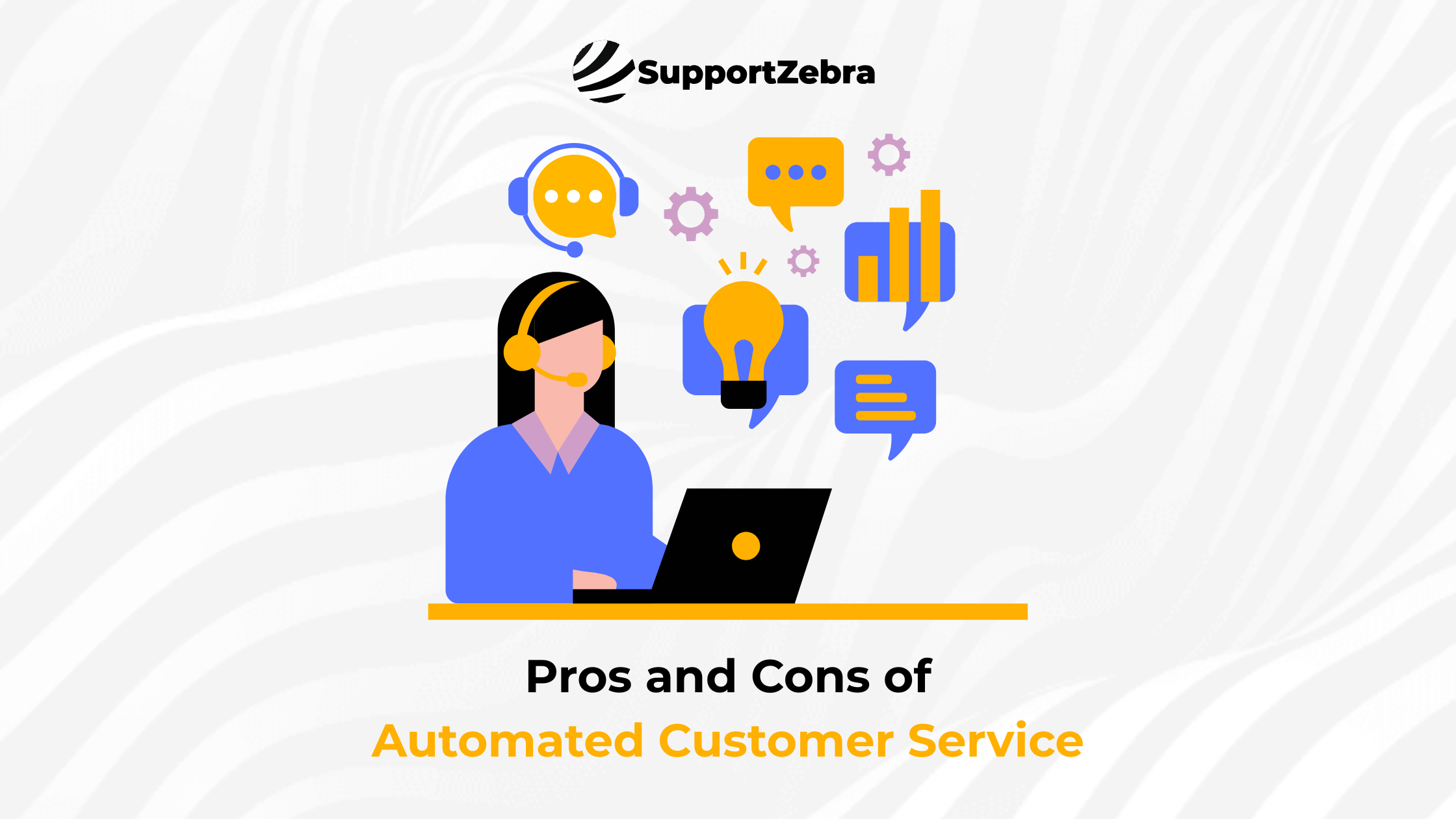A Clear Look at Automated Customer Service Advantages and Risks
Key Takeaways:
- Automated customer service helps businesses handle high volumes of inquiries quickly and cost-effectively, but it works best when paired with human support for complex or sensitive issues.
- When bots can’t solve unique problems or prevent access to real agents, customer satisfaction drops. Avoiding over-automation is key to maintaining trust and loyalty.
- Lean teams can utilize automation for FAQs and ticket routing, but should ensure that real human help is available when needed to maintain a strong brand connection.
- A thoughtful blend of automation and live support enables businesses to strike a balance between speed and empathy.
- SupportZebra helps companies strike that balance for seamless, scalable customer experiences.
When customers reach out, they expect fast, accurate, and helpful responses every time. But if your team is drowning in tickets or stuck answering the same questions over and over, response times slip, frustrations build, and customer satisfaction takes a hit. Left unchecked, this can damage your reputation and result in the loss of valuable business.
That’s where automated customer service comes in, not as a replacement for your team but as a powerful support system. In this blog, we’ll break down the pros and cons so you can decide if it’s the right move for your business and how to implement it without losing the human touch.
What Are the Main Benefits of Automated Customer Service?
Automated customer service can significantly boost efficiency, reduce costs, and improve response times. For companies handling high volumes of customer inquiries, it creates structure and consistency that’s hard to achieve manually. When done right, automation enhances—not replaces—your support experience.
Key benefits include:
- 24/7 availability to help customers even outside business hours.
- Faster response times with instant replies to common queries.
- Cost savings by reducing the need for large support teams.
- Scalability during peak seasons without needing to hire additional agents.
- Consistent messaging with pre-approved scripts and answers.
These tools are especially effective for handling repetitive, low-complexity questions such as password resets, shipping updates, or FAQs. For businesses seeking to enhance response times while controlling costs, automation can deliver a substantial return on investment.
Where Does Automated Customer Service Fall Short?
Despite its advantages, automation comes with limitations. When customers have complex issues or emotional frustrations, bots can appear cold or unhelpful. Poorly designed systems can also misinterpret requests, leading to delays and dissatisfaction.
Some of the most common drawbacks include:
- Lack of empathy or human understanding in sensitive or emotional situations.
- Frustration from customers when stuck in endless chatbot loops.
- Limited ability to resolve unique or high-complexity problems.
- Initial setup and maintenance costs for advanced systems.
- Risk of over-reliance, which can make your brand feel impersonal.
If your automation isn’t seamless, it can do more harm than good. For many businesses, the right approach involves blending automation with human support.
When Should a Business Use Automated Customer Service?
Automation is most effective when used to enhance speed, volume, and consistency; however, timing and context are also crucial. If your business is scaling fast, facing a high volume of repetitive inquiries, or operating across time zones, automation can help prevent burnout and backlog.
Ideal use cases include:
- Handling FAQs like shipping times, return policies, or account access.
- Routing tickets or directing customers to the correct department.
- Managing live chat during high-traffic periods.
- Offering proactive support via notifications or reminders.
- Supporting multilingual or global customers round-the-clock.
However, if your support relies heavily on personalization, nuanced decision-making, or building long-term relationships, a purely automated solution might not be the best fit.
How Do Customers Feel About Automated Support?

Customer sentiment toward automation is mixed. Many appreciate quick answers and self-service tools, especially for simple issues. However, patience runs thin when automation becomes a barrier rather than a bridge to help.
What customers like:
- Instant answers
- 24/7 availability
- Not having to wait on hold
What customers dislike:
- Not getting a human when needed
- Chatbots misunderstanding their concerns
- Repetitive responses that don’t resolve the issue
To maintain trust, businesses should always offer an easy way to escalate to a live agent. Transparency and flexibility go a long way in making automation feel supportive rather than frustrating.
Can Automation Work for Small Businesses?
Absolutely. In fact, small and mid-sized businesses often benefit the most from automation, particularly when trying to accomplish more with limited resources. It allows lean teams to provide quick and efficient support without compromising quality.
Ways small businesses can use automation:
- Auto-responders for common email inquiries.
- Chatbots on websites to handle basic questions.
- Automated workflows for ticket routing.
- CRM-integrated tools for personalized support.
However, small businesses must be careful not to over-automate. The personal touch is often a key strength—so make sure automation supports it, not replaces it.
What Tools Are Commonly Used for Automated Customer Service?
There’s a wide range of tools businesses can use to automate parts of their support function, from basic auto-replies to AI-powered virtual assistants. The right mix depends on your volume, complexity, and budget.
Popular tools include:
- Chatbots for websites and mobile apps.
- AI assistants that learn from past interactions.
- Automated ticket routing systems.
- Self-service knowledge bases.
- CRM integrations that trigger custom workflows.
- Voice response systems (IVR) for phone support.
Many platforms, like Zendesk, Intercom, and Freshdesk, offer built-in automation features tailored for businesses of all sizes.
How Can Businesses Avoid Common Automation Mistakes?
The biggest mistake businesses make is thinking automation is a complete replacement for human support. Automation should enhance the experience, not block access to real help when needed.
Tips to avoid missteps:
- Always provide an option to speak with a live representative.
- Regularly review bot conversations to refine responses.
- Avoid using automation for emotionally charged or high-risk issues.
- Train your support team to work alongside automation tools.
- Gather feedback from customers on their automated support experience.
Automation is most successful when it’s viewed as a support layer, not a standalone solution.
How Can Automation Be Personalized for Better Results?
Modern tools allow for surprisingly personalized automation when integrated with customer data. The more context your system has, the more human the experience feels—even if it’s a bot on the other end.
Ways to personalize:
- Use customer names and order histories in replies.
- Suggest help articles based on past behavior.
- Trigger follow-up messages after resolved issues.
- Provide multilingual support tailored to location or individual preference.
- Align tone and style with your brand voice.
Intelligent automation should feel like an extension of your brand, not a cold, scripted message.
What Does a Balanced Customer Service Strategy Look Like?
A balanced strategy combines the speed of automation with the empathy of human support. It’s not about choosing one over the other—it’s about using each where they shine.
Elements of a strong hybrid approach:
- Use bots for common questions and live agents for complex ones.
- Let automation handle the volume, but keep humans for relationship-building and customer service.
- Offer clear escalation paths when automation falls short.
- Monitor performance to adjust in real-time.
- Align all tools under a unified customer experience strategy.
This blend enables businesses to remain efficient while preserving the human element that customers value.
Is Automated Customer Service Right for Every Business?
Not always. The effectiveness of automated customer service depends on your audience, the complexity of your offerings, and your company’s goals. For some, it’s a game-changer. For others, it may be more trouble than it’s worth.
Ask yourself:
- Do you receive a high volume of repetitive questions?
- Are your customers open to self-service tools?
- Can you invest in a quality setup and ongoing maintenance?
- Is there a clear path to escalate to human support?
If the answer to most of these is yes, automation might be the edge you need. If not, focusing on human-powered service could be a better route.
Talk to Our Team About Automation That Works

Automated customer service can be a powerful tool, but only when it’s used thoughtfully. The right automation can boost efficiency, cut costs, and improve customer satisfaction. But over-automating or relying on the wrong tools can frustrate customers and damage your brand. The key is finding the right balance between automation and human connection. That’s where SupportZebra comes in.
At SupportZebra, we design custom support solutions that blend intelligent automation with skilled human agents, so your customers always feel heard, understood, and cared for. Let’s build a support system that scales with you, not against you. Contact us today to discover how we can enhance your customer service without compromising the personal touch.

